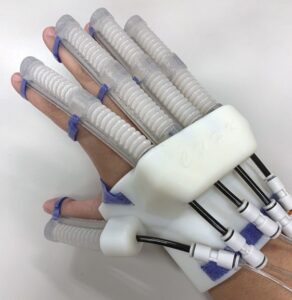 An example of a 3D-printed robotic hand that Dr. Sai Praveen is seeking to create through his interdisciplinary research on stroke rehabilitation.
An example of a 3D-printed robotic hand that Dr. Sai Praveen is seeking to create through his interdisciplinary research on stroke rehabilitation.By Dave DeFusco
An interdisciplinary team of Katz School researchers is investigating the potential for wearable devices connected to the internet to facilitate the rehabilitation of stroke patients who have lost mobility in their arms.
Dr. Sai Praveen, a postdoctoral research fellow in the Katz School’s M.S. in Artificial Intelligence program, and Ziyang Guo, a master’s student in the Katz School’s Data Analytics and Visualization program, are creating a model to study how signals from the brain collected through electrodes placed on wearable devices can accurately predict the little movements that healthy people take for granted, like reaching for a toothbrush or trying on new shoes.
Most of these movements involve simple reflexes and signaling from the brain to our arms, hands and fingers. But for many people—nearly 800,000, according to the CDC, who have a stroke each year in the United States and an estimated 90 percent who suffer from paralysis—those acts are nearly impossible. An ischemic stroke, the most common, occurs when a blood vessel supplying blood to the brain is obstructed.
Dr. Praveen is trying to meld medicine, science and engineering to better understand how a device, such as a 3D-printed robotic hand, or exoskeleton, in combination with surface electromyography (sEMG) sensors that measure physiological responses can facilitate efficient and accurate clinical decision-making for patients at home. Surface EMG, which doesn’t pierce the skin, detects a muscle’s electrical activity, and sensors connected to a network can share data with other connected devices and management systems.
“We’re using the wearable devices for data collection,” said Dr. Praveen, “and deep-learning algorithms to extract efficient features and improve the accuracy of our model.”
Advances in artificial intelligence, machine learning and other data-driven tools are playing a central role in rehabilitation decision-making and protocol development. Machine learning, which is a methodology that provides computers with the ability to learn from experience, is a promising technique for outcome prediction because of its high accuracy and ability to process large volumes of data.
“On the other hand, deep-learning methods are gaining prominence in rehabilitation procedures, owing to their prowess in identifying distinct features from large volumes of data,” said Dr. Praveen.
The project also involves students in the Katz School’s M.S. in Biotechnology Management and Entrepreneurship program, who are exploring the use of novel components that will help improve the design of exoskeletons. They are evaluating the benefits of using force and pressure sensors, along with sEMG sensors, to improve the efficiency of an exoskeleton.
“We aim to include students from Occupational Therapy Doctorate program for designing gestures that are close to active daily living,” said Dr. Praveen, “and at the same time ensure the accuracy of classification.”
Guo’s role in the project is using machine learning algorithms to recognize the sEMG signal of 52 different hand gestures. The team is exploring the possibility of observing and analyzing the sEMG signal to check the differences between stroke patients and healthy people when they perform the same gestures.
“If there is a lack of signaling in a patient’s sEMG when they perform a particular gesture,” said Guo, “then therapists could focus on training them on that gesture. In this way, the rehabilitation process to restore function becomes more efficient.”
